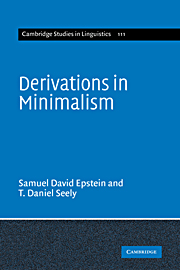4 - More challenges to the elimination of the EPP: some movement cases
Published online by Cambridge University Press: 09 October 2009
Summary
Introduction
In this chapter, we consider further challenges to our proposed elimination of A-chains, the EPP, and at least some cases of successive cyclic A-movement. The data examined here all involve evidence that a DP has moved through the spec of a non-control infinitival to position. Since the spec of non-control to is not a Case-checking position, it can't be that movement is motivated by Case. The EPP, then, is implicated in such cases.
We will first review, in Section 2, the basic phenomena to be dealt with. Next, we consider one recent analysis of it, that of Bošković (2002). Like our own, Bošković's approach rejects the EPP. But, interestingly, Bošković's approach may not be compatible with our hypothesis that there are no A-chains, and it is not compatible with our contention that there is no movement to, or through, spec of this non-control to. After reviewing Bošković, we consider potential problems with his analysis, in Section 3. In Section 4 we consider, rather speculatively, a set of alternative proposals that reject the EPP and that also reject successive cyclic A-movement, while accounting for core data with independently motivated mechanisms. Finally, in Section 5 we briefly consider some of the arguments (not dealt with in earlier discussion) for the EPP based on work by Lasnik, in a series of important recent papers.
Evidence for successive cyclic A-movement as evidence for the EPP
We argued in Chapters 2 and 3 above that raising to has no formal checking features.
- Type
- Chapter
- Information
- Derivations in Minimalism , pp. 113 - 173Publisher: Cambridge University PressPrint publication year: 2006

